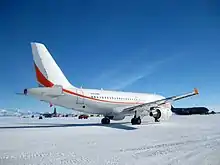Aeronautical mobile (OR) service
Aeronautical mobile (OR) service (short: AMS; | also: aeronautical mobile radiocommunication service') is – according to Article 1.34 of the International Telecommunication Union's (ITU) Radio Regulations (RR)[1] – defined as «An aeronautical mobile service intended for communications, including those relating to flight coordination, primarily outside national or international civil air routes.»
- See also

Classification
Variations of this radiocommunication service in line to the ITU Radio Regulations article 1 are as follows :
Mobile service (article 1.24)
- Aeronautical mobile service (article 1.32)
- Aeronautical mobile (R)° service (article 1.33)
- Aeronautical mobile (OR)°° service (article 1.33)
- Aeronautical mobile-satellite service (article 1.35)
- Aeronautical mobile-satellite (R)° service (article 1.36)
- Aeronautical mobile-satellite (OR)°° service (article 1.37)
(R)° = abbreviation to route flights (route)
(OR)°° = abbreviation to flights others than on routes (off-route)
Frequency allocation
The allocation of radio frequencies is provided according to Article 5 of the ITU Radio Regulations (edition 2012).[2]
In order to improve harmonisation in spectrum utilisation, the majority of service-allocations stipulated in this document were incorporated in national Tables of Frequency Allocations and Utilisations which is within the responsibility of the appropriate national administration. The allocation might be primary, secondary, exclusive, and shared.
- primary allocation: is indicated by writing in capital letters (see example below)
- secondary allocation: is indicated by small letters
- exclusive or shared utilization: is within the responsibility of administrations
However, military usage, in bands where there is civil usage, will be in accordance with the ITU Radio Regulations. In NATO countries military utilizations will be in accordance with the NATO Joint Civil/Military Frequency Agreement (NJFA).[3]
- Example of frequency allocation
| Allocation to services | ||
| Region 1 | Region 2 | Region 3 |
2 850–3 155 MHz
| ||
3 025–3 025 MHz
| ||
- Examples aeronautical off-route (OR) utilisation
.jpg.webp) US Navy Grumman C-2 UHF/VHF-Aircraft station used for Aeronautical mobile (OR) service
US Navy Grumman C-2 UHF/VHF-Aircraft station used for Aeronautical mobile (OR) service Airbus A319 in the Antarctic region
Airbus A319 in the Antarctic region US Air Force transport aircraft on the Antarctic region
US Air Force transport aircraft on the Antarctic region
References / sources
- ITU Radio Regulations, Section IV. Radio Stations and Systems – Article 1.34, definition: aeronautical mobile (OR) service / aeronautical mobile (OR) radiocommunication service
- ITU Radio Regulations, CHAPTER II – Frequencies, ARTICLE 5 Frequency allocations, Section IV – Table of Frequency Allocations
- "NATO Joint Civil/Military Frequency Agreement (NJFA)" (PDF). Archived from the original (PDF) on 2016-03-04. Retrieved 2016-11-15.